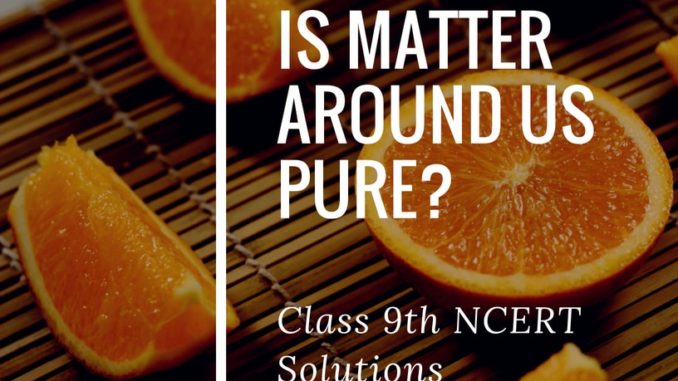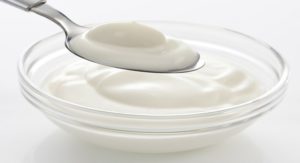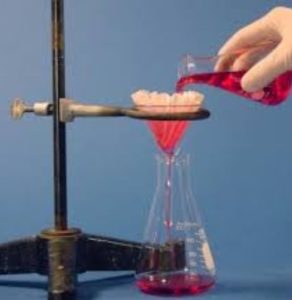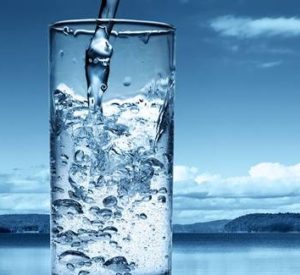
Science is an important subject for school and college students. In our previous article, we shared CBSE Class 10 Science Solutions with you. Today, you can check Class 9 Science NCERT Solutions of the Chapter Is Matter Around Us Pure. Don’t forget to share this with your younger brothers and sisters who are studying in class 9th.
Class 9 Science NCERT Solutions
Here you can check Class 9 Science NCERT Solutions. We have given answers of both Science NCERT Box questions and NCERT Back Exercise Questions of Chapter 2, Is Matter Around Us Pure. Have a look:-
NCERT Texbook Page 15
What is meant by a substance?
A substance is made up of particles. There are 2 types of particles, Pure substances and Impure substances. Pure substances are made up of same type of particles.
List the point of differences between homogenous and heterogeneous mixtures.
Homogeneous mixtures
- A homogeneous mixture is the one in which 2 or more substances gets mixed easily.
- There is no boundary of separation
Ex. Sugar in Water
Heterogeneous mixtures
- A heterogeneous mixture is the one in which the substances does not get mixed completely.
- They have a clear boundary of separation.
Sand in water
Q.3. How are sol, solution and suspension different from each other?
Solute
- Size of particle is between 1 nm to 100nm.
- It scatters light.
- It is stable in nature.
Solution
- The size of solution particles is not more than 1 nm.
- .Light is not scattered
- Stable in nature
Suspension
Particles of size is more than 100 nm
It can scatter a beam of light.
Q.4. To make asatured solution 36g of sodium chloride is mixed with 100g of water at 293K. Find its concentration at this temperature.
Mass of solute= 36g
Mass of solvent (water) = 100g
Solution’s Mass in total= Mass of solute + Mass of solvent
36g + 100g = 136g
Concentration= Mass of solute/Mass of solution X 100
=36/100 * 100 = 26.4%
So the concentration is 26.4 %
Class 9 Science NCERT Solutions: NCERT Box Questions
NCERT Textbook Page 24
Q.1. How will you separate a mixture containing kerosene and petrol (difference in their boiling points is more than 25C), which are miscible with each other?
We can use the process of distaiilation to separate the mixture of petrol and kerosene.
Take the mixture in a distillation flask and start heating it. Petrol has lower boiling point so petrol will condense first and kerosene will remain in the container in which the mixture is taken.
Also Check: Class 9 Science Solutions of Chapter 1
Q.2. Name the technique to separate

(i) Butter from Curd
(ii) Salt from Sea Water
(iii) Camphor from Salt
Ans. 2. (i) Centrifugation
(ii) evaporation
(iii) Sublimation
Q.3. What types of mixtures are separated by the technique of crystallisation?
Ans. 3. Crystallisation is used to separate a solid from a solid-liquid mixture to obtain the solute. Ex. Separation of Salt from Sea Water.
NCERT Solutions for Class 9 Science: Chapter 2
NCERT Box Questions Pg 24
Q.1. Classify the following as physical and chemical changes.
- Cutting of trees
- Melting of butter in pan
- Rusting of Almirah
- Boiling of water to form steam
- Passing of electric current, through water and the water breaking down into hydrogen and oxygen gas.
- Dissolving common salt in water
- Making fruit salad wth raw fruits
- Burning of Paper and Wood
Ans. 1.
- Physical Change
- Physical change
- Chemical change
- Physical change
- Chemical change
- Physical change
- Physical change
- Chemical Change
Q.2. Try segregating the things around you as pure substances or mixtures.
Ans. 2. Check for the following things in your sorroundings.
Pure Substances Salt, Bottled water, Pulses etc
Mixture: Sugar in water, Lemonade, Milk, Air etc
Class 9 Science NCERT Solutions
NCERT Back Exercise Questions/Solutions
Q.1 Which separation techniques will you apply for the separation of the following?

(a) Sodium Chloride from its solution in water
(b)Ammonium Chloride from a mixture containing sodium chloride and ammonium chloride
(c) Small pieces of metal in the engine oil of a car.
(d) Different pigments from an extract of flower petals.
(e) Butter from Curd
(f) Oil from Water
(g) Tea leaves from tea
(h) Iron pins from sand
(i) Wheat grains from husk.
(j) Fine mud particles suspended in water
Ans.
(a)Evaporation
(b)Sublimation
(c)Filtration
(d)Chromatography
(e) Centrifugation
(f) Separating Funnel
(g) Filtration
(h) Magnetic separation
(i) Winnowing/sedimentation
(j) Decantation and Filtration
Q.2. Write the steps you would use to make tea. Use the words solution, Solvent, solute, dissolve, soluble, insoluble, filtrate and residue.
Ans. 2.
- Take Water in a container in which you wish to prepare the tea.
- This water will be the solvent. Now add tea leaves, and sugar as solute.
- Switch on the gas and put the container on the gas and let it heat.
- Now the container contains a solution of tea leaves, sugar and water
- Add milk to it and let the solution be heated.
- After the tea is prepared switch of the gas and filter it out with a stainer.
- The tea you pour in a cup is the filtrate and the residue in this case will be the tea leaves which will be collected in the stainer. Sugar gets dissolved in the solution as it is soluble in water and the tea leaves are insoluble in water.
Q.3. Pragya tested the solubility of three different substances at different temperatures and collected, the data as given below( results are given in the following table, as grams of substance dissolved in 100 grams of water to form a saturated solution).
(a) What mass of Potassium nitrate would be needed to produce a saturated solution of potassium nitrate in 50 grams of water at 313 K?
(b) Pragya makes a saturated solution of potassium chloride in water at 353 K and leaves the solution to cool at room temperature. What will she observe as the solution cools? Explain
(c) Find the solubility of each salt at 293 K. Which salt has the highest solubility at this temperature?
(d) What is the effect of change of temperature on the solubility of a salt?
Ans.
Mass of KNO3= 62g (for 100h satured solution) at 313K
Mass if KNO3 in 50 grms of water at 313K= 62 X 50 / 100 = 31 gms
(b) KCl crystals will be obtained when we cool down the satured solution.
(c) Solubility of each salt at 293K
(i) Potassium nitrate 32 g
(ii) Sodium chloride 36 g
(iii) Potassium Chloride 35 gm
(iv) Ammonium Chloride 37 gm
(d) Solubility of the salt increases when the temperature is increased.
Q.4. Explain the following giving examples:
(a) Saturated Solution
(b) Pure Substance
(c)Colloid
(d) Suspension
(a) Saturated solution is a type of solution in which no more solute can be dissolved in the solvent. It has reached the maximum limit of the solute which can be dissolved in the solvent.
(b) Those substances which has same type of particles are known as Pure Substances. They have a uniform composition of particles. For ex. Copper
(c) A colloid is such a solution in which the solute particles are bigger in size than the true solution. Ex. of colloid is our blood.
(d) Suspension


Leave a Reply